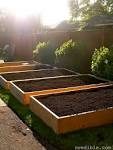GIY Weekly Column September 9th 2017 How To Build And Grow In Raised Beds
Raise your growing game…
Over the last few years I’ve noticed a definite snootiness about using raised beds for growing food, which I find ridiculous. It’s almost like if you are not out there double digging your soil and breaking your back to suffer for your vegetables then it’s considered cheating. Personally I am all for the occasional cheat if it helps me to grow better veggies or helps me to grow them with less time and effort expended.
Generally speaking you need a good spade’s depth of quality top soil in order to grow good veggies. Unfortunately GIYers now face twin barriers to this approach – poor soil depth/quality in their garden, and lack of time to spend improving the soil quality. In most housing estates in Ireland for example the ‘soil’ was created by departing builders throwing a miserly inch-thick layer of top soil on top of the builder’s rubble – not the most promising growing medium.
A “raised bed” is created by adding a good layer (at least a foot) of soil on top of the existing soil, usually using a frame of timber to keep the soil in place. Instead of digging down in to the soil therefore, you are effectively raising the level of it up by a foot. The raised bed is therefore an ingenious cheat to provide, good quality, deep, fertile soil that’s perfect for planting. It goes without saying that if you are blessed with good quality, deep soil in your garden and plenty of time for digging, then you don’t need raised beds. But if you don’t, by bringing good quality soil in to raised beds in your garden, you can start growing promising veggies instantly.
They have a number of other benefits. Typically, you don’t ever stand on the soil which means less soil compaction and therefore better drainage (the soil will dry out quicker). They also tend to extend the growing season because the soil in raised beds warms up earlier than the soil around it. You can therefore start planting earlier in the season. The dreaded slugs tend to be less of an issue too because they face more barriers to get in to the bed.
When it comes to the shape and look of your raised beds you can let your imagination run riot, but don’t sacrifice functionality for aesthetics. I went nuts a few years back making triangular-shaped beds – they looked lovely but were highly impractical. The important thing to remember is that you are not supposed to be walking on the soil at any point, so you must be able to reach in to the centre of the bed from the sides. A 4ft (1.2m) wide bed is therefore considered ideal because the centre of the bed can be reached from both sides (depending how long your arms are I guess!). The beds should be a minimum of 25cm deep. You can go deeper if you want (even up to waist height) – deeper beds have the advantage of being easier to work at (no stooping etc) but they drain very quickly and are therefore difficult to keep watered in summer. You also need a serious load of soil to fill them.
A typical argument against raised beds is their cost. In reality you can spend as much or as little as you want. You can buy raised beds or make them yourself from old scaffolding planks or salvaged timber.
The Basics – 5 Step Plan to Make Raised Beds
A simple 5-step plan to put raised beds on to a lawn is as follows:
1. Measure out the lengths of wood needed, cut them to size and nail them together.
2. Support from the inside using wooden pegs, then nail the planks to the pegs for support.
3. Place a thick layer of wet cardboard or newspaper at the bottom to kill off grass and weeds.
4. Fill with alternating layers of manure/compost and top soil. A mix of about 60 per cent soil and 40 per cent compost would be ideal.
5. Fill the beds to within about 10cm of the top so that the sides of the bed act as a windbreak.
Autumn is a great time to put in raised beds. If you get them built in the autumn and early winter and filled with soil and compost, you can cover them down for the rest of the winter so that they will be bursting with nutrients and ready for planting next spring.
You can buy top soil in garden centres but it will be expensive. Specialist soil mix providers like Enrich sell larger quantities (1-tonne bags). Ask at your local GIY group, gardening club, or allotment organisation. Failing that, keep an eye on local papers. Ask to see the soil before it’s delivered – you do not want a lorry load of subsoil full of stones and weeds.




